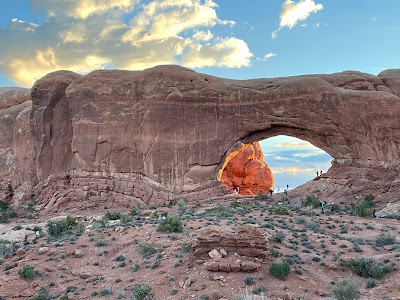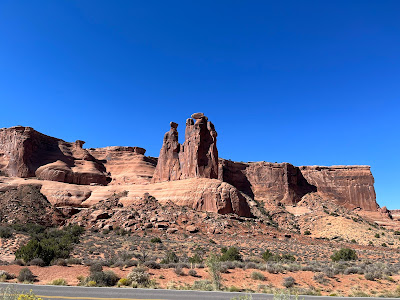I'm no stranger to sunrise silhouettes. A tree a half mile south of our house has become my "sunrise tree," and it's been photographed in every season - from leafy silhouette of summer to the stark, bare branches of winter's cold.
An old, unused silo is another of my typical sunrise silhouettes. From our vantage point on the flatlands of Kansas, the silo towers into the sky, giving a focal point for the varied colors and positions of the rising sun in the skies just east of our house.
 |
| Sunrise, October 27, just south of our house on the SF/RN County line |
But sunrise at the Arches National Park in Utah provided a unique backdrop to sunrise during our retirement trip in October.After we were turned away the day before because the park was "too full," we entered Arches before any park rangers could check out Randy's lifetime National Parks pass. But we certainly weren't alone. There were plenty of other cars winding their way up dark, curvy roads, hoping to catch first light. Though moms will tell you, "Don't follow the crowd!" we did in this case, hoping that others might know the best place to watch the sunrise.
We - and probably 200 others - ended up at the Windows Trail. The photos don't do it justice. But it was one of my favorite experiences during the trip.
While I climbed up some rocks, I wasn't as adventurous as some of these people who actually experienced sunrise inside an arch. (You can see them, if you look closely at the photos.)
 |
| The South Window (left) and the North Window (right) |
Arches Park contains more than 2,000 natural arches within the maze of red sandstone fins. Arches has the greatest concentration of arches in the country. Water and ice, extreme temperatures and underground salt movement are responsible for the sculptured rock scenery of Arches. Balanced rocks and tall spires add to the landscape.
In the Windows area, you can see many stages of arch formation. Some arches are hard to see because of rock walls behind them. Entrada Sandstone - the rock in which arches are formed - was deposited as sand more than 150 million years ago. Over time, it was buried by new layers, hardened into rock and shaped by the powerful forces of erosion.
After the sun was up, the light on the arches changed. But the light show wasn't just to the east.
As the day dawned, the light cast on rock formations as we looked to the west changed constantly, too.Even though the rock seems permanent and unchanging, it's not. The landscape of the park continues to change as rain falls, the wind buffets the rock surfaces and erosion occurs.
From that parking lot, we could also walk to the Double Arch.
We weren't the only ones trekking to the Double Arch. A wedding party made their way along the path. We could hear the cheers later, as we reached the parking area, when they were announced husband and wife by the park ranger.
It would be a memorable place for a wedding, all right!
The bride wasn't the only one with a bouquet. Nature provided some flowers as well.
Not all the arches were massive. The arches range in size from a 3-foot opening - the minimum considered an arch - to the longest, Landscape Arch, measuring 306 feet base to base. (I think you must have to hike awhile to see it because we didn't it.) But it does demonstrate how the park constantly evolves. In 1991, a rock slab 60 feet long, 11 feet wide and 4 feet thick fell from the underside of Landscape Arch, leaving behind an even thinner ribbon or rock.
At the Delicate Arch, the top is a 5-foot-thick layer of Moab Tongue. A remnant of an ancient fin, the arch today has an opening 45 feet high and 33 feet wide. Water and time have sculpted Delicate Arch, and erosion continues to slowly wear away the features. Although it will eventually succumb to the same forces that created it, the arch now stands as an iconic feature of the American West.
Later, in the gift shop, there was a copy of the first known photo taken of the Delicate Arch, back in 1906.
While the arches are the main attraction, there are plenty of other formations, including the Fiery Furnace.
The path to the Sand Dune Arch was like walking on a beach.
We squeezed through narrow fins to find a hidden room, flanked by rock walls.
Arches also includes ancient petrified sand dunes. Some 200 million years ago, the area was covered by extensive sand dunes. Winds from the northwest carried tons of fine-grained sand into the area, creating an immense desert. Over time, the sand drifts were covered by other layers of sediment, compressed and cemented by quartz and calcite into Navajo Sandstone. Erosion has since washed away the overlying layers, exposing the petrified dunes.
When my kids were little, we used to find shapes in the clouds dotting the Kansas skies.
All the different rock formations had me looking for animals and other figures among the rocky spires.

It was too dark to take a photo at the Arches sign as we entered the park before sunrise. So we captured the moment as we left - after a stop in the gift shop, of course.
































.JPEG)
Mesa Verde and the Canyonlands were spectacular and Arches National Park is equally so! Man is so tiny in the vast grandeur of these amazing places.
ReplyDeleteEven though I joke that we saw "lots of rocks," each park had unique qualities and its own beauty.
Delete